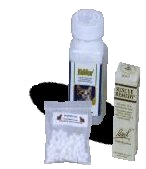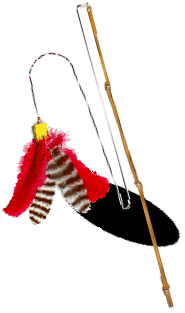 A cat is a carnivore, and needs a diet of meat. Unlike dogs, cats are
unable to digest vegetable protein, unless it has already been
partially digested, for example in the stomachs of their prey.
A cat is a carnivore, and needs a diet of meat. Unlike dogs, cats are
unable to digest vegetable protein, unless it has already been
partially digested, for example in the stomachs of their prey.
Grannies Pet Supermarket: a UK online pet store.
 A cat is a carnivore, and needs a diet of meat. Unlike dogs, cats are
unable to digest vegetable protein, unless it has already been
partially digested, for example in the stomachs of their prey.
A cat is a carnivore, and needs a diet of meat. Unlike dogs, cats are
unable to digest vegetable protein, unless it has already been
partially digested, for example in the stomachs of their prey.
The primary source of food energy is protein, which should form 25 to 30 percent of a cat's diet. Protein can come from meat, fish, eggs and dairy products. However, protein is also taxing on the kidneys so should not be fed to excess, especially to older cats or ones with kidney problems.
Cats also need a lot of fat, far more then humans. A diet of up to 40 percent fat is considered healthy for felines. This is processed more efficiently by the cat's metabolism, so is not nearly such a burden on the kidneys. This is one of the reasons why diets for old cats increase the ratio of fat to protein.
Another five percent of the cat's diet comes from simple carbohydrates, or sugars. You can feed your cat complex carbohydrates such as potatoes or pasta, but only if they are cooked first to convert the complex carbohydrates to simple ones.
Vitamins should be provided by the cat's normal diet. If a proprietary balanced cat food is being fed, it may be dangerous to give vitamin supplements.
A cat should never be given milk as a substitute for water, as the lower amount of fluid can cause kidney damage. Also many cats, like some people, are lactose intolerant, so milks which are low in lactose should be provided.
It is also a good idea, if using commercial foods, to give your cat a mixture of moist and dry foods, as although moist foods may taste better, dry foods are better for the teeth, and can be left down all day without going off for your cat to snack on.
The Healthy Cat
 Cats are very good at hiding their illnesses, so it is up to the owner
to find them out. There are a few regular checks which can help with
this.
Cats are very good at hiding their illnesses, so it is up to the owner
to find them out. There are a few regular checks which can help with
this.
Unusual Threats to Health
One often unrecognised threat to a cat's health is its litter.
Clay
clumping litters have killed both cats and rabbits. Remember that
when cats use a litter box they often lick themselves clean, and so
there is a considerable likelihood that they will ingest the litter.
Consider this in the context of a cat litter that swells to many times its volume, and even warns that it can block plumbing. The swelling clay can have dire consequences for the cat who swallows it - and even occasionally the owner who breathes it.
Another problem is feline vaccination sarcoma. There is no particular vaccine which causes tumours, but the tumours which can result from vaccination are often fatal.
Luckily, the incidence of these tumours is rare - less than 0.13 per cent, so the risk still justifies vaccinating your cat. There are also some precautions which can lessen the risk.
More information on cat health may be found at the Feline Advisory Bureau web site.
 Though indoor cats live longer, it is vitally important to give them
the same quality of life as that experienced by cats who go out.
Boredom can lead to behavioural problems such as toileting problems or
aggression.
Though indoor cats live longer, it is vitally important to give them
the same quality of life as that experienced by cats who go out.
Boredom can lead to behavioural problems such as toileting problems or
aggression.
Cats like to climb, and can get untold hours of pleasure out of a series of shelves or perches at different heights. A 'cat tree' with sisal posts will also provide somewhere for the cat to scratch other than the sofa.
Variety is the spice of life, and cats love to explore new things just as much as we do. A box with holes in it for jumping, hiding and peeking can hold their attention for much longer than you might think.
Another way of keeping your cat occupied is to hide part, or all, of its food in places around the house, making it hunt and explore as it would in the wild. It is important to remember where you put the food, though, as gifts to ants and mice are a bad idea, and even dried food can go off in the end.
Remember, play is pretend hunting, so when you're playing try to think like a mouse or bird. Small, twitching movements on the spot should alternate with quick running to keep your cat interested and alert. Near the end of playtime the game should slow down - allow the prey to 'die', and thus become less interesting for the cat, although it may still play with it.
In a two cat household one may 'hog' the toy, but try to include the other, perhaps wriggling the line attached to the toy at it, or simply waiting until the more dominant cat has got bored.